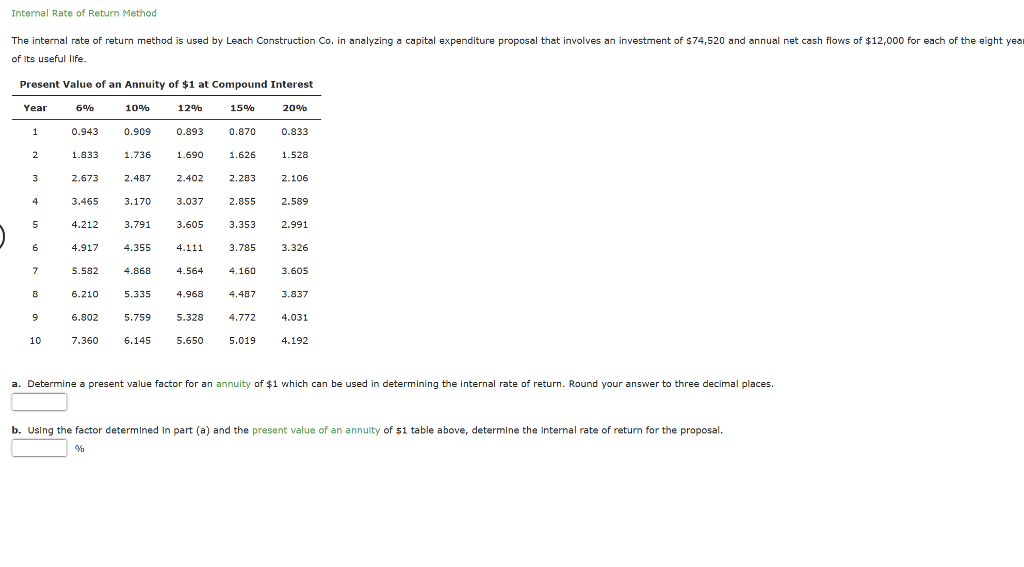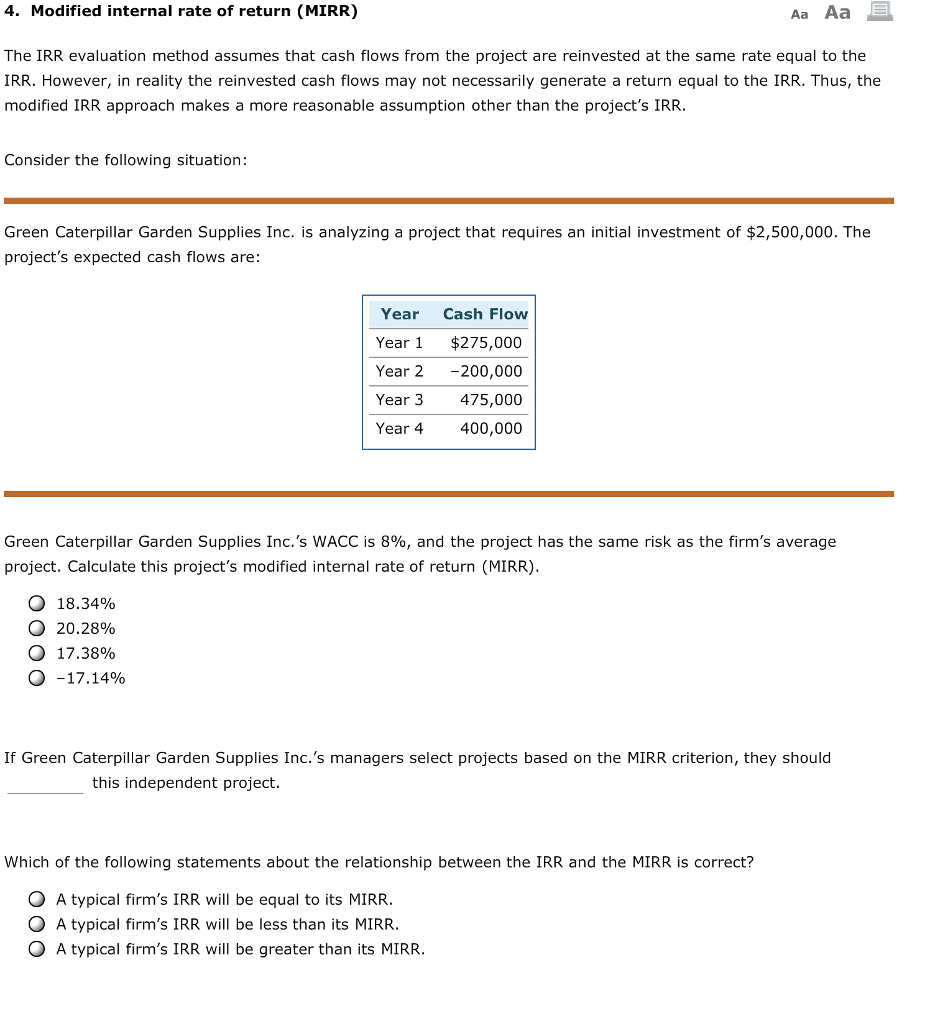
If another project has a similar IRR with less up-front capital or simpler extraneous considerations, then a simpler investment may be chosen despite IRRs. ROI is the percentage increase or decrease of an investment from beginning to end. It is calculated by taking the difference between the current or expected future value and the original beginning value, divided by the original value, and multiplied by 100. WACC is a measure of a firm’s cost of capital in which each category of capital is proportionately weighted. All sources of capital, including common stock, preferred stock, bonds, and any other long-term debt, are included in a WACC calculation.

Get in Touch With a Financial Advisor
The internal rate of return is the discount rate that would bring this project to breakeven, or $0 NPV. As can be seen, although the total return is different the IRR is still the same. Put in other words, IRR is neutral to reinvestments made at the same rate.
Internal Rate of Return (IRR) Rule: Definition, Formula & Example
- For instance, a company might use IRR to decide whether to open a new retail outlet or to renovate and expand an existing one.
- As Daniel Garza, CFA, who manages a research team at registered investment advisor Corient explains, “IRR is often used to determine the feasibility of investment projects.”
- It’s the discount rate that makes the net present value (NPV) of all cash flows from a particular project equal to zero.
- Yes, using IRR to obtain net present value is known as the discounted cash flow method of financial analysis.
- The IRR is more helpful in comparative analysis than in isolation as one single value.
- It is calculated by taking the difference between the current or expected future value and the original beginning value, divided by the original value, and multiplied by 100.
Given that the company’s cost of capital is 10%, management should proceed with Project A and reject Project B. Consider the following example to better understand the application of the internal rate of returns (IRR). The internal rate of return gauges the break-even rate of any project. The investment strategies, of course, are much more diverse in the commercial real estate (CRE) industry, since properties like office buildings are purchased, rather than companies. But from a more in-depth look, if the multiple on invested capital (MOIC) on the same investment is merely 1.5x, the implied return is far less impressive.
What is the approximate value of your cash savings and other investments?
They provide essential perspectives on project performances and helps in focusing on the profit targets by taking into account the time value of money. But whether to select ROI or IRR, depends on the type and complexity of the investment and its objective. To determine the internal rate of return (IRR) on the LBO investment in Excel, follow the steps below. In the context of a leveraged buyout (LBO) transaction, the minimum internal rate of return (IRR) is usually 20% for most private equity firms.
The internal rate of return rule is a guideline for evaluating whether to proceed with a project or investment. The IRR rule states that if the IRR on a project or investment is greater than the minimum RRR—typically the cost of capital, then the project or investment can be pursued. In theory, any project with an IRR greater than its cost of capital should be profitable. In planning investment projects, firms will often establish a required rate of return (RRR) to determine the minimum acceptable return percentage that the investment in question must earn to be worthwhile. While both projects could add value to the company, one will likely be the more logical decision as prescribed by IRR. Note that because IRR does not account for changing discount rates, it’s often not adequate for longer-term projects with discount rates that are expected to vary.
When selecting among several alternative investments, the investor would then select the investment with the highest IRR, provided it is above the investor’s minimum threshold. The main drawback of IRR is that it is heavily reliant on projections of future cash flows, which are notoriously difficult to predict. IRR is usually more useful when you are comparing across multiple projects or investments, or in situations where it is difficult to determine the appropriate discount rate. NPV tends to be better for when cash flows may flip from positive to negative (or back again) over time, or when there are multiple discount rates. Internal rate of return (IRR) is the discount rate at which a project’s returns become equal to its initial investment.
For example, if you invest $50 every month in the stock market over a 10-year period, that money would turn into $7,764 at the end of the 10 years with a 5% IRR, which is more than the current 10-year Treasury (risk-free) rate. Because the stream of payments is equal and spaced at even intervals, an alternative approach is to discount these payments at a 4.8% interest rate, which will produce a net present value of $200,000. Alternatively, if the payments are raised to, say $1,100, the IRR of that loan will rise to 5.2%. For example, you might use it to evaluate whether Investment A or Investment B is the better use of your capital. IRR could also help determine whether it is more profitable to establish a new operation or expand your existing one.
The IRR itself is only a single estimated figure that provides an annual return value based on estimates. Since estimates of IRR and NPV can differ drastically from actual results, most analysts will choose to combine IRR analysis with scenario analysis. Scenarios can show different possible NPVs based on varying assumptions.
Another is that it doesn’t take any irregular or uncommon forms of cash flow into account—if there are any, using the IRR rule will produce misleading findings. In certain scenarios, this metric is ineffective; this includes projects with a fluctuating life span and projects involving an unpredictable cash flow. Also, this tool cannot be applied in isolation; net present value (NPV) is required for proceeding with this method. It even ignores future costs and reinvestment rate of the cash flows, thus failing to provide the actual profitability. Remember, a project can have multiple IRRs in its lifespan when the cash flows fluctuate; therefore, the analyst cannot rely on a single IRR value. This particular drawback is overcome by using the modern methods of determining IRR.
Another way of putting that is that the upfront cost of the initial investment is equal to the present value of its future cash flows, and since these two are equal, the net present value is zero. Internal rate of return (IRR) is one of several well-known formulas used to evaluate prospective investments. It allows you to calculate an investment’s potential gains over a certain period of time and determine whether it’s a worthwhile venture. Companies and analysts may also look at the return on investment (ROI) when making capital budgeting decisions. ROI tells an investor about the total growth, start to finish, of the investment. The two numbers normally would be the same over the course of one year but won’t be the same for longer periods.
As mentioned, most companies do not rely on IRR and NPV analyses alone. These calculations are usually also studied in conjunction with a company’s WACC and an RRR, which provides for how are dividends taxed how are they reported further consideration. Any project with an IRR that exceeds the RRR will likely be deemed profitable, although companies will not necessarily pursue a project on this basis alone.